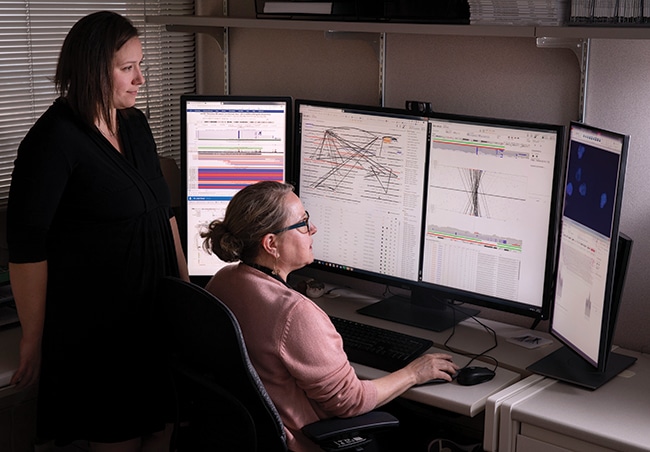Anne Paxton
November 2019—The LUVOIR telescope proposed this year by NASA, when it is launched into orbit, will outperform the Hubble Telescope 40-fold in ability to detect and visualize deep space objects in detail. But while dazzling in concept, the LUVOIR is still in development. Interestingly, at the genomic level, a similarly impressive advance in detection called mate pair sequencing has already progressed from research to clinical use in diagnosing cancer.
With mate pair sequencing, a novel next-generation sequencing technique, Mayo Clinic is advancing the laboratory’s current capabilities for visualizing genetic rearrangements, thus increasing the diagnostic yield of testing for a variety of neoplasms.
“Traditionally, as cytogeneticists, we have the ability to look on a single-cell level at chromosomes in a karyotype, but those tests are qualitative and depend on the quality of the metaphases. You are looking by eye,” says Linda Baughn, PhD, co-director of Mayo’s genomics laboratory and assistant professor of laboratory medicine and pathology. “Sometimes a rearrangement is cryptic, where you just cannot see it. Mate pair sequencing is an unbiased whole genome molecular test that allows us to precisely identify the rearrangement without relying on people to see it visually using a microscope.”
Just as a high-powered telescope might do with details of distant space objects, mate pair sequencing, or MPseq, can more precisely characterize the genomic complexity, providing fresh insight beyond what is detectable by fluorescence in situ hybridization or chromosome studies. By allowing detection of structural rearrangements with higher resolution compared with FISH or conventional chromosome analysis, MPseq enables characterization of precise genomic rearrangement breakpoints.
“Almost all cancers have some kind of rearrangements,” Robert Jenkins, MD, PhD, professor of laboratory medicine and pathology at Mayo, says. “They generate structural abnormalities that either disrupt the structure of the DNA or generate messenger RNA or fusion RNA or change the area of the genome where they are inactive to active. The chromosome studies just don’t have the resolution to detect the mechanism of what genes are being involved in the rearrangements. They only have a resolution of approximately five to 10 megabases, and that is not good enough.”

At Mayo Clinic (from left): Linda Baughn, PhD; Patricia Greipp, DO, consultant, Division of Laboratory Genetics and Genomics; Nicole Hoppman, PhD; and Beth Pitel, MS, CG(ASCP). They and other Mayo researchers didn’t realize the level of complexity associated with some hematologic neoplasms until they started looking at mate pair, Pitel says. [Photo: Joseph Kane]
“Mate pair is a game-changer for the field of cytogenetics,” says study coauthor Jess F. Peterson, MD, also a co-director of the Mayo genomics laboratory and associate professor of laboratory medicine and pathology.
Dr. Peterson began at Mayo in 2017 as the lab was poised to be the first to go live with the AML mate pair test for clinical use. As that milestone was reached, “I was amazed at the precision of this assay,” he says. “We have heavily relied upon conventional chromosome analysis and FISH to detect recurrent abnormalities associated with hematologic neoplasms, including gains, losses, and chromosomal rearrangements. Utilizing mate pair sequencing, we can confidently detect copy number abnormalities, in addition to chromosomal rearrangement breakpoints at the gene exon/intron level.”
Mayo researchers did not realize the level of complexity associated with some hematologic neoplasms until they started looking at mate pair, says study coauthor Beth Pitel, MS, CG(ASCP)CM, a development technologist at Mayo. “FISH and chromosomes are wonderful, but mate pair helps structurally characterize those cases that fall into the atypical realm.” For a particular chromosome result, for example, if it is uncertain what genes are involved in the translocation, the laboratory can perform mate pair and resolve it.
While most samples Mayo processes have been heme-based, the laboratory also has live clinical assays for constitutional and solid tumor evaluations. “We have had a number of congenital cases where we want to fully characterize what is happening chromosomally and assess the genes that are at certain breakpoints,” Pitel says.
Tumor lineage testing—analyzing two tumors from a patient to determine whether they are from a single primary tumor—is another potential application Mayo is exploring. And more uses likely lie ahead. “We have developed an assay for AML, but using the exact same technology, the exact same chemistry, the exact same tools, we have actually seen more cases where we are using mate pair sequencing as a reflex test. So we can be talking about any disease,” she says.
The instrumentation needed to perform MPseq is not complicated or unusual for laboratories equipped to perform NGS. “Equipment-wise, you need a wet bench,” Pitel says. Mayo uses the Illumina Nextera reagent kit and Covaris ultrasonicator for its library prep, which is currently done manually but could be performed using automated liquid handlers. “We sequence on an Illumina HiSeq platform, but we could move to more advanced sequencers like the NovaSeq, and that would drive our costs down. You also need a thermal cycler” to amplify DNA and RNA samples by PCR, “but that is standard lab equipment these days.”

Hutton Kearney, PhD, above right (with Pitel), leads the software development team that created a dynamic visualization interface that supports the lab by providing an interactive experience for those who analyze and interpret MPseq data.
However, a significant amount of infrastructure and support has been necessary for this assay to be brought to the level of a clinical-grade test, Pitel says. A dynamic visualization tool, Mayo Clinic Ingenium, was a primary goal for the group prior to launch of the assay. The software development team (led by Hutton Kearney, PhD, and Stephanie Smoley) created a dynamic visualization interface that supports the laboratory in a number of ways by creating an interactive experience for those who analyze and interpret MPseq data. The software can, among other things, track each case through lab director signout, create publication-grade images depicting genomic rearrangements, and display historical data. “The development of Mayo Clinic Ingenium has been paramount to the success of this assay,” Pitel says.
Among its other advantages, mate pair resolves a practical limitation of FISH assays, Dr. Peterson says. “As more disease-specific abnormalities are discovered, the development and validation of new FISH probes is simply not feasible. We have to use a technology that will allow us to evaluate the entire genome of these neoplasms.” Replacing FISH is the eventual goal.
The ideal sample for analysis is a diagnostic specimen with at least 20 percent tumor burden, “below which we start to lose our sensitivity,” Pitel says. “Where we would normally pick up subclonal rearrangements, or copy number gains or losses with lower tumor burden, we start to see fewer sequencing fragments that would support a structural rearrangement. We can overcome these limitations, to a point, with deeper sequencing if we know about the low tumor burden ahead of time.”
Ideally, turnaround time for an MPseq case is about two weeks, which is typical of NGS. Higher test volumes and the ability to process more samples simultaneously in the future may reduce the TAT. “Right now we run a wet bench MPseq library prep once a week,” Pitel says. “If our volumes increase, then the clinical team will adapt by running multiple batches a week, decreasing the TAT. The more samples we have, the more adaptability the wet bench has, and the lower the TAT will be.”
This would not be the ideal assay for someone who, for example, has acute promyelocytic leukemia and for whom the laboratory needs to detect the PML-RARA fusion immediately, Dr. Peterson says. “For those kinds of cases we would run our FISH probe up front for quick results.” However, Dr. Peterson has seen cases of APL with RARA rearrangements that were not detected by RARA FISH probe sets (Peterson JF, et al. Cancer Genet. 2019;237:51–54). “Mate pair sequencing was performed and revealed either a cryptic PML-RARA fusion or a variant RARA rearrangement,” he says. “These are truly cryptic translocations that are undetectable using traditional cytogenetic techniques.”
Could other laboratories adopt Mayo’s mate pair sequencing application? Dr. Peterson is unsure. “It would be possible only if genetic laboratories heavily invest in the NGS platforms and the bioinformatics. A tremendous amount of support is required.”
The point of mate pair is not only to make a diagnosis or change the prognosis for a patient but also to determine how a patient will be treated. “I can only speak to hematologic neoplasms,” Dr. Peterson says. “But using mate pair we are able to detect gene fusions that may respond to targeted therapy, such as tyrosine kinase inhibitors.” He knows of many patients who have been able to be treated but might not have been in the absence of mate pair sequencing analysis. In fact, MPseq is part of the Mayo Clinic algorithm for the evaluation of Ph-like ALL when a breakpoint detected by conventional analysis suggests a disruption of a known 3′ kinase gene but a FISH probe is not available. “The technique has afforded Mayo Clinic the ability to define novel 5′ gene partners,” he says.The Mayo Clinic team continues to explore the use of mate pair in other malignancies. “We are currently validating the B-ALL, T-ALL, and plasma cell myeloma assays,” and results so far have been surprising, he reports. “We are finding abnormalities that we would have never suspected based on chromosomes and FISH results.”

Dr. Peterson
Dr. Peterson believes mate pair could be applied to all areas of genetics to characterize any kind of translocation. “If you want to know specifics in greater detail of what is happening, mate pair is going to be the test.”
Dr. Baughn points out, however, that FISH still has its benefits: “FISH is currently much less expensive than an NGS test, and the limit of detection is better compared to our current mate pair algorithm for classically described cytogenetic abnormalities.”
 CAP TODAY Pathology/Laboratory Medicine/Laboratory Management
CAP TODAY Pathology/Laboratory Medicine/Laboratory Management
